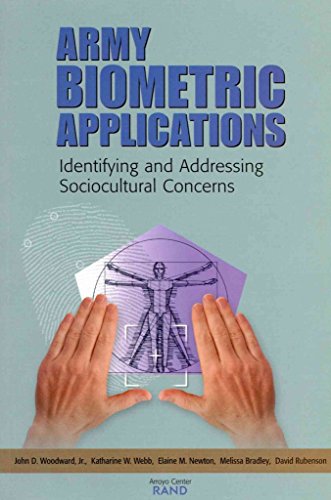Items related to Army Biometric Applications: Identifying and Addressing...

Every human possesses more than one virtually infallible form of identification. Known as biometrics, examples include fingerprints, iris and retinal scans, hand geometry, and other measures of physical characteristics and personal traits. Advances in computers and related technologies have made this a highly automated process through which recognition occurs almost instantaneously. With concern about its information assurance systems and physical access control increasing, the Army has undertaken an assessment of how it can use biometrics to improve security, efficiency, and convenience.
"synopsis" may belong to another edition of this title.
From the Publisher:
The digitized Army of the twenty-first century depends on secure command, control, communications, and computers to ensure dominance on the battlefield. Biometrics has been suggested as a means to enhance this security.While the word sounds very new and high-tech, "biometrics" refers to an old and basic concept--recognition. Specifically, biometrics are physical characteristics or personal traits of a person that can be measured and used to identify, or verify the claimed identity of, that person. In the context of this report, biometrics refer to commercially viable automated methods of identifying or verifying the identity of a living person in real time based on a physical characteristic or personal trait of that individual. Examples include fingerprints, hand and finger geometry, iris and retinal scanning, and voice and facial recognition.In addition to securing the digitized Army, biometrics may also be useful to the Army in such functions as access control to weapons systems, facilities, and computer networks. They may be an effective way to protect military ID cards, particularly if the military moves to smart cards that could carry financial, medical, or other sensitive information. Biometrics could also improve efficiency and reduce fraud in the many human resource service programs the Army provides.The technology's promise combined with policymakers' interest have raised the profile of biometrics. Congress has directed the Army to evaluate the feasibility of, and requirements for, a center to house a number of biometrics activities, including technical research and development, test and evaluation, and a biometric template repository.As with all identification information, biometrics carry the potential to reduce the anonymity of individual actions. In the United States, our society and culture value privacy greatly. This value is reflected in our laws. Hence, a feasibility assessment of a biometrics program and center must include an analysis of the sociocultural issues that might be raised in response to an Army program. This report documents RAND's findings regarding Army use of biometrics. Specifically, the Army asked RAND to review the current technology and to examine the legal, sociological, and ethical concerns associated with Army use of biometrics and the establishment of an Army biometric center. This report also suggests ways the Army might address these concerns and discusses the feasibility of an Army biometric center. The concerns raised and corresponding solutions will likely affect almost any organization intending to make use of biometrics. Lieutenant General William H. Campbell, Director of Information Systems for Command, Control, Communications, and Computers (DISC4) and the Army's Chief Information Officer, sponsored this work. Phillip Loranger of the Information Assurance Office served as RAND's primary point of contact. The research was conducted in the Force Development and Technology Program of RAND's Arroyo Center, a federally funded research and development center sponsored by the U.S. Army.
Review:
Although prepared for the US Army, this report may be the best available technology assessment of biometrics.
Future Survey, June 2002
Future Survey, June 2002
"About this title" may belong to another edition of this title.
- PublisherRAND Corporation
- Publication date2001
- ISBN 10 0833029851
- ISBN 13 9780833029850
- BindingPaperback
- Number of pages184
Buy New
Learn more about this copy
US$ 21.88
Shipping:
US$ 3.99
Within U.S.A.
Top Search Results from the AbeBooks Marketplace
Army Biometric Applications Format: Paperback
Published by
National Book Network
(2001)
ISBN 10: 0833029851
ISBN 13: 9780833029850
New
Softcover
Quantity: > 20
Seller:
Rating
Book Description Condition: New. Brand New. Seller Inventory # 0833029851
Buy New
US$ 21.88
Convert currency

